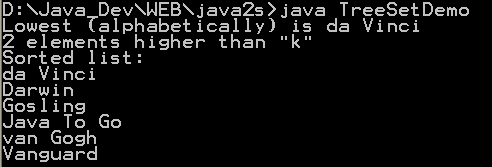Things you can do with Sets

// : c11:Set1.java
// Things you can do with Sets.
// From 'Thinking in Java, 3rd ed.' (c) Bruce Eckel 2002
// www.BruceEckel.com. See copyright notice in CopyRight.txt.
import java.util.Arrays;
import java.util.HashSet;
import java.util.LinkedHashSet;
import java.util.Set;
import java.util.TreeSet;
public class Set1 {
static void fill(Set s) {
s.addAll(Arrays.asList("one two three four five six seven".split(" ")));
}
public static void test(Set s) {
// Strip qualifiers from class name:
System.out.println(s.getClass().getName().replaceAll("\\w+\\.", ""));
fill(s);
fill(s);
fill(s);
System.out.println(s); // No duplicates!
// Add another set to this one:
s.addAll(s);
s.add("one");
s.add("one");
s.add("one");
System.out.println(s);
// Look something up:
System.out.println("s.contains(\"one\"): " + s.contains("one"));
}
public static void main(String[] args) {
test(new HashSet());
test(new TreeSet());
test(new LinkedHashSet());
}
} ///:~
Related examples in the same category
| 1. | Set, HashSet and TreeSet | | |
| 2. | Set operations: union, intersection, difference, symmetric difference, is subset, is superset | | |
| 3. | Set implementation that use == instead of equals() | | |
| 4. | Set that compares object by identity rather than equality | | |
| 5. | Set union and intersection | | |
| 6. | Set with values iterated in insertion order. | | |
| 7. | Putting your own type in a Set | |  |
| 8. | Use set | |  |
| 9. | Another Set demo | | |
| 10. | Set subtraction | |  |
| 11. | Working with HashSet and TreeSet | |  |
| 12. | TreeSet Demo | |  |
| 13. | Show the union and intersection of two sets | | |
| 14. | Demonstrate the Set interface | | |
| 15. | Array Set extends AbstractSet | |  |
| 16. | Sync Test | | |
| 17. | Set Copy | | |
| 18. | Set and TreeSet | | |
| 19. | Tail | | |
| 20. | What you can do with a TreeSet | |  |
| 21. | Remove all elements from a set | | |
| 22. | Copy all the elements from set2 to set1 (set1 += set2), set1 becomes the union of set1 and set2 | | |
| 23. | Remove all the elements in set1 from set2 (set1 -= set2), set1 becomes the asymmetric difference of set1 and set2 | | |
| 24. | Get the intersection of set1 and set2, set1 becomes the intersection of set1 and set2 | | |
| 25. | Extend AbstractSet to Create Simple Set | | |
| 26. | Int Set | | |
| 27. | One Item Set | | |
| 28. | Small sets whose elements are known to be unique by construction | | |
| 29. | List Set implements Set | | |
| 30. | Converts a char array to a Set | | |
| 31. | Converts a string to a Set | | |
| 32. | Implements the Set interface, backed by a ConcurrentHashMap instance | | |
| 33. | An IdentitySet that uses reference-equality instead of object-equality | | |
| 34. | An implementation of the java.util.Stack based on an ArrayList instead of a Vector, so it is not synchronized to protect against multi-threaded access. | | |
| 35. | A thin wrapper around a List transforming it into a modifiable Set. | | |
| 36. | A thread-safe Set that manages canonical objects | | |
| 37. | This program uses a set to print all unique words in System.in | | |
| 38. | Indexed Set | | |
| 39. | An ObjectToSet provides a java.util.Map from arbitrary objects to objects of class java.util.Set. | | |
| 40. | Sorted Multi Set | | |
| 41. | Fixed Size Sorted Set | | |
| 42. | Set operations | | |
| 43. | A NumberedSet is a generic container of Objects where each element is identified by an integer id. | | |
| 44. | Set which counts the number of times a values are added to it. | | |
| 45. | Set which counts the number of times a values are added to it and assigns them a unique positive index. | | |
| 46. | Indexed Set | | |
| 47. | A set acts like array. | | |
| 48. | Implements a Bloom filter. Which, as you may not know, is a space-efficient structure for storing a set. | | |
| 49. | Implementation of disjoint-set data structure | | |
| 50. | Call it an unordered list or a multiset, this collection is defined by oxymorons | | |